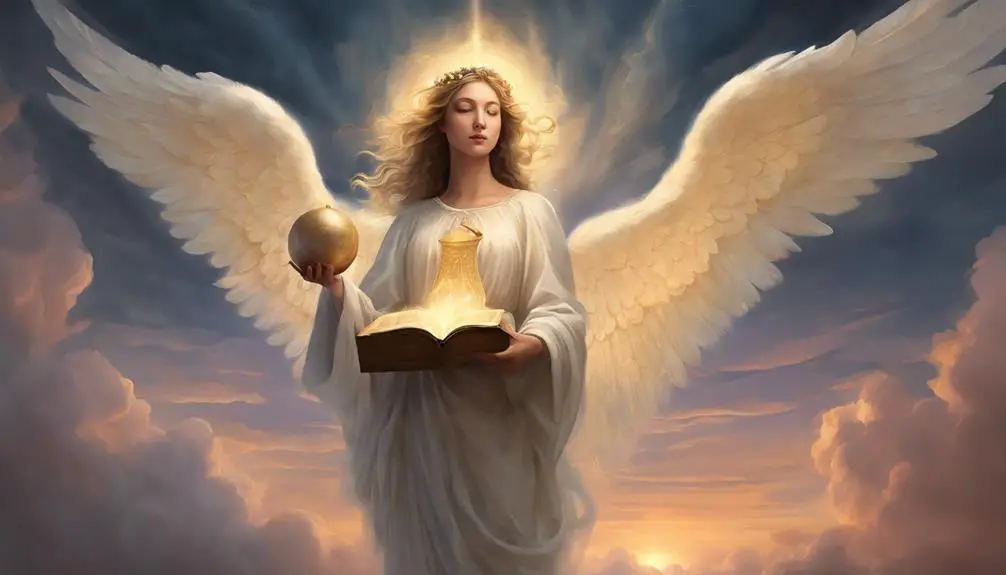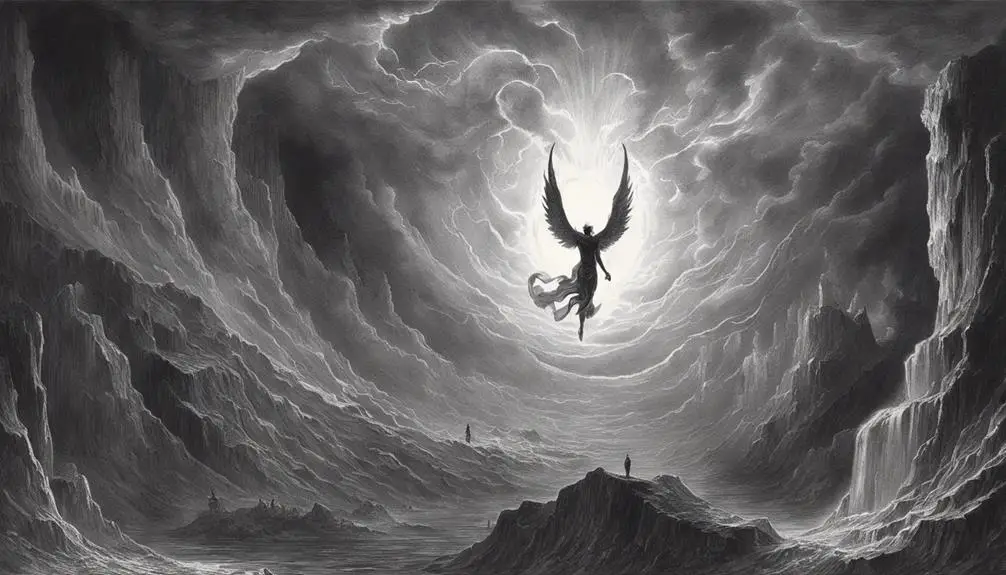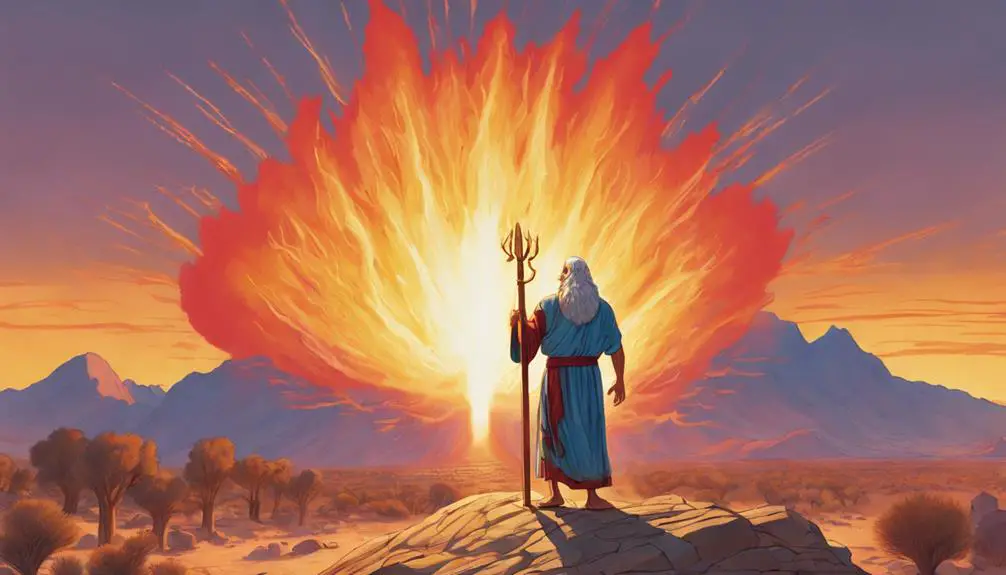Navigate the illuminating roles of light bearers in the Bible, from Genesis to Jesus, and unravel their significance in divine wisdom.

Light Bearer in the Bible
Did you know that the phrase 'light bearer' appears in various contexts within the Bible, each carrying its own unique symbolism and significance?
As you explore the narrative from the Genesis of Light to Jesus being hailed as the ultimate Light Bearer, you'll uncover how this motif weaves through the tapestry of biblical stories, offering insights into divine guidance, wisdom, and salvation.
The journey from Lucifer's fall as the morning star to Moses's encounter with the burning bush, and the prophets serving as beacons of hope, invites a deeper understanding of light's multifaceted role in spiritual enlightenment.
This exploration promises to shed new light on familiar passages, encouraging you to consider the profound impact of light bearers in shaping the biblical message and its reflections in modern Christianity.
Key Takeaways
- Light symbolizes divine wisdom and guidance, with Jesus portrayed as the ultimate beacon of this illumination.
- Biblical stories use light to depict God's presence, guidance, and revelation, from creation to prophetic visions.
- Jesus's life and teachings serve as a model for ethical living, emphasizing love, compassion, and moral integrity.
- The symbolism of light in the Bible inspires followers to pursue paths of righteousness, enlightenment, and spiritual growth.
The Genesis of Light

In the biblical narrative, the command 'Let there be light' marks a pivotal moment, signifying not only the inception of physical illumination but also symbolizing the emergence of divine order from chaos. This phrase, encapsulating the essence of the creation story, heralds the onset of existence as known within the Judeo-Christian tradition. It's not merely about the literal dawn of light but rather introduces the concept of divine illumination, a beacon guiding the unfolding of the universe.
You'll find this moment in Genesis isn't just about separating day from night. It's a profound assertion of divine authority and wisdom, establishing a pattern of orderliness that pervades the entire scripture. The act of divine speech bringing forth light serves as a metaphor for enlightenment, both physical and spiritual. It suggests that understanding and wisdom originate from a divine source, illuminating the path for humanity.
Analyzing this, you realize the command transcends its immediate context, offering insights into the nature of divine power. It implies that divine illumination is foundational, not just to the material world, but also to moral and spiritual order. This moment in the creation story serves as a cornerstone, illuminating the relationship between divinity, wisdom, and the cosmos.
Lucifer: Morning Star's Fall

Turning our gaze from the dawn of creation, we confront the story of Lucifer, whose fall from grace epitomizes the perils of hubris and the complex interplay of light and darkness within the divine narrative. This tale isn't just a mythological account; it serves as a poignant analysis of defiance against the celestial hierarchy. You'll find that Lucifer, once a paragon of beauty and wisdom, embodies the ultimate angelic rebellion. His quest for power, driven by vanity and pride, led to his expulsion from the divine realms.
Delving deeper, you'll see that Lucifer's fall underscores a pivotal theme: the consequences of challenging established authority. It's a cautionary tale that resonates within the fabric of many religious and philosophical teachings. The celestial hierarchy, meticulously structured, reflects an order not just of power but of responsibility and duty. Lucifer's attempt to usurp this order disrupted the cosmic balance, illustrating the chaos that follows from disobedience and arrogance.
Understanding Lucifer's story requires recognizing the intricate dynamics of light and shadow in spiritual narratives. His descent from the morning star to a symbol of darkness encapsulates a profound spiritual paradox: light's potential to engender its opposite. This narrative invites you to ponder the delicate equilibrium of the cosmic order and the role that ambition and pride play in disrupting this balance.
Moses and the Burning Bush

Amidst the wilderness of Sinai, Moses' encounter with the burning bush marks a pivotal moment of divine revelation, symbolizing a profound transformation in his personal journey and in the broader narrative of Israelite liberation. This divine encounter on sacred ground not only serves as a turning point for Moses but also as a foundational event that underscores the intricate relationship between divine communication and human action in the biblical tradition.
Aspect |
Description |
Implication |
|---|---|---|
Divine Encounter |
Burning bush not consumed by fire |
Manifestation of God's presence |
Sacred Ground |
Removal of sandals; holy place |
Reverence and submission |
Transformation |
Moses from shepherd to leader |
Personal and communal change |
Divine Command |
Liberation of Israelites commanded |
Directive for action |
Significance |
Covenant between God and Israel reaffirmed |
Renewed faith and purpose |
You're invited to explore how this encounter illustrates the profound manner in which divine messages are imparted through extraordinary phenomena, emphasizing the sacredness of communication with the divine. The burning bush episode highlights the significance of being open to divine guidance, illustrating the transformative power of direct divine intervention in human affairs.
Prophets as Beacons of Hope

Building on the theme of divine encounters, it's essential to explore how prophets have served as beacons of hope, guiding people through periods of uncertainty with messages from the divine. Delving into the Old Testament, you'll find that prophets like Elijah and Isaiah weren't just messengers; they were embodiments of hope, illuminating paths with profound insights and miraculous acts.
Elijah's miracles, for instance, weren't mere displays of divine power. They were critical interventions during times of despair, offering tangible hope to those who witnessed them. His acts, from the resuscitation of the widow's son to the confrontation with the prophets of Baal, underlined a crucial message: faith in the divine brings deliverance.
Similarly, Isaiah's visions served as a beacon of hope, but in a different light. They painted a picture of future redemption and restoration, urging people to hold onto faith amidst adversity. Isaiah's prophecies weren't just foretellings; they were reassurances that, despite current tribulations, a brighter future was ordained by the divine.
Through their lives, Elijah and Isaiah exemplified how hope, anchored in faith and manifested through divine acts and visions, guides humanity. Their stories remind you that, even in the darkest times, there are divinely sent beacons of hope lighting the way forward.
Jesus: The Ultimate Light Bearer

In the narrative of the Bible, Jesus emerges as the quintessential Light Bearer, illuminating the path to salvation with unparalleled clarity and authority. His life and teachings provide a beacon of divine illumination and spiritual guidance, transcending temporal concerns to focus on eternal truths.
- Incarnation as Illumination: Jesus's incarnation itself symbolizes the ultimate act of divine illumination, bringing the light of God's presence into a world shrouded in spiritual darkness.
- Teachings as Light: His teachings, parables, and sermons, especially the Sermon on the Mount, serve as a lamp guiding the feet of those seeking righteousness and peace.
- Miracles as Testimony: The miracles of Jesus, from healing the sick to calming storms, testify to his authority over both the natural and spiritual realms, showcasing his role as the light overcoming darkness.
- Sacrifice as the Ultimate Beacon: His sacrificial death and subsequent resurrection are the pinnacle of spiritual guidance, offering hope and a way to redemption, symbolizing the victory of light over darkness.
Through these acts and teachings, Jesus embodies the role of the ultimate Light Bearer, offering a model of divine illumination and spiritual guidance that continues to inspire and direct humanity towards a higher calling.
Reflections in Modern Christianity

Modern Christianity reflects deeply on the enduring legacy of Jesus as the Light Bearer, examining how his teachings illuminate contemporary spiritual journeys and ethical dilemmas. You see this reflection in the way believers and theologians alike grapple with the relevance of Jesus' message in today's culturally diverse and ethically complex world. His ethical teachings, emphasizing love, compassion, and forgiveness, serve not only as a spiritual compass but also as a foundation for addressing modern moral questions.
The cultural impact of Jesus as the Light Bearer is profound, shaping art, literature, and social norms. You're invited to consider how this influence continues to mold personal identities and collective values, guiding decision-making and ethical standards within communities and nations. Moreover, the metaphor of light, representing truth, wisdom, and goodness, encourages a reflective and discerning approach to life's challenges.
In your exploration of modern Christianity, you delve into how Jesus' role as the Light Bearer offers insights into living a life aligned with ethical teachings amid the complexities of the 21st century. This journey underscores the timeless relevance of his message, inspiring continued reflection and action within the fabric of contemporary society.
Frequently Asked Questions
How Do Other Religious Texts Outside of the Bible Conceptualize the Role or Symbol of Light in Relation to Divinity or Guidance?
In exploring how other religions view light's role in divinity or guidance, you'll find Light in Islam and Vedic metaphors offer rich insights.
Islam describes light as Allah's guidance, illuminating the path for believers.
The Vedas, ancient Hindu scriptures, use light metaphors to symbolize knowledge and enlightenment, guiding individuals towards truth.
Both perspectives highlight light's universal role as a beacon of wisdom and a divine guide across different faiths.
In What Ways Has the Symbolism of Light Been Depicted in Religious Art Throughout History, Particularly in Non-Christian Traditions?
Throughout history, you've seen light's symbolism in religious art evolve. Think medieval times, but with Instagram-worthy Gothic architecture using stained glass to capture divine light.
Similarly, in Zen gardens, light plays a key role, not through structures, but in how sunlight transforms the space, guiding contemplation.
These examples show light's universal role in guiding spirituality, transcending cultures and religions, proving its timeless appeal in connecting humans to the divine.
How Do Psychological or Philosophical Interpretations of Light Symbols in the Bible Compare With Traditional Religious Explanations?
When you delve into the psychological and philosophical interpretations of light symbols in sacred texts, you're exploring cognitive symbolism and philosophical metaphysics.
Unlike traditional religious explanations that often take these symbols at face value, this analytical approach seeks deeper meanings. It connects light not just to divinity or morality but to human cognition and the essence of being.
You're not just reading a text; you're unlocking the layers of human understanding and universal truths.
Can the Concept of a Light Bearer Be Found in Any Secular or Scientific Contexts, and How Does It Compare to the Religious Concept?
Imagine a scientist working tirelessly on photosynthesis research, aiming to enhance crop growth. In this secular context, they're a 'light bearer,' illuminating paths for sustainable agriculture.
Unlike the religious notion, here, the focus is on practical solutions to challenges like light pollution, affecting both our environment and health.
This approach brings a tangible dimension to the concept, showcasing how scientific endeavors can be likened to carrying light, offering insights and solutions.
What Role Does the Metaphor of Light Play in Contemporary Spiritual Practices Not Directly Related to Christianity, Such as New Age Movements or Modern Paganism?
In contemporary spiritual practices like New Age movements or modern paganism, the metaphor of light plays a crucial role. You'll find it deeply integrated into energy healing and visualization techniques, signifying purity, enlightenment, or transformation.
Unlike traditional religious contexts, here, light often represents personal growth and the harnessing of cosmic energies. These practices encourage you to visualize light as a tool for healing, empowering you to connect with your inner spirituality.
Conclusion
In your journey through the tapestry of biblical narratives, you've witnessed the profound motif of light—a beacon guiding humanity from the dawn of creation to the pivotal moments of divine intervention. Remarkably, it's in the embrace of this celestial luminance that you find both ancient wisdom and contemporary relevance.
As you reflect on the stories of light bearers, from the first flicker in Genesis to the radiant glow of Jesus, consider the serendipitous illumination they cast on your own path. This journey, illuminated by sacred texts, enriches your understanding and offers a beacon of hope in the quest for spiritual enlightenment and moral guidance, showcasing the timeless interplay between divine light and human destiny.



Sign up